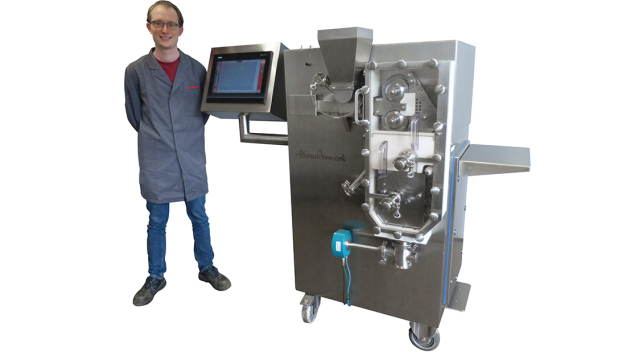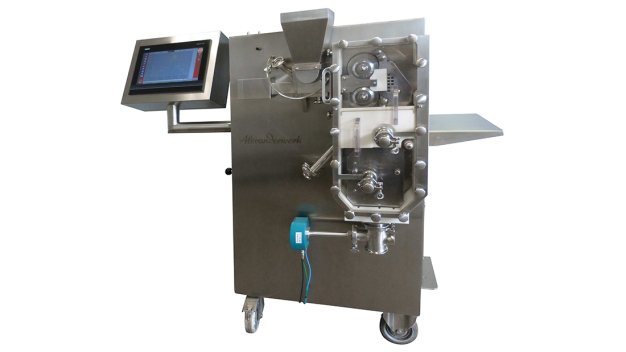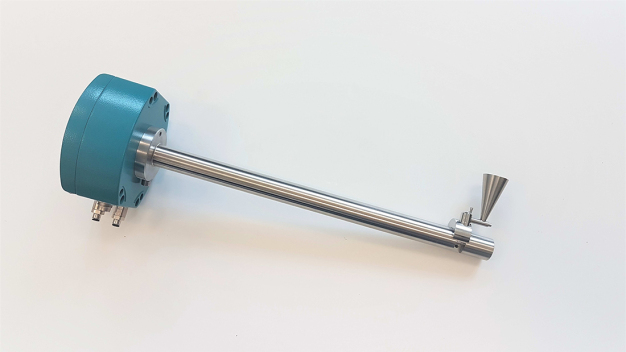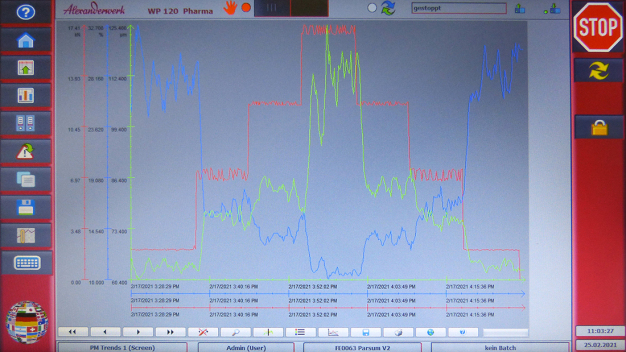- Systems
Quality assurance without loss of time: roller press with PAT interface monitors particle size of continuously produced granules in real time
Inline measurement technology in the pharmaceutical, chemical and food industries - Plant manufacturer and measurement technology specialist develop PAT solutions for continuous manufacturing in R&D collaboration
Until now, the quality of many end and intermediate products in the chemical, pharmaceutical and food industries has been determined by time-consuming laboratory analyses. As a result, product quality is only assessed retrospectively. This causes large time delays in the release of produced batches and can lead to the production of off-spec material without it being noticed during production. As a result, the advantages of continuous production processes cannot be fully exploited.
A new solution for continuous dry granulation has been developed by Alexanderwerk GmbH and Parsum GmbH in a recently completed joint research project. A PAT solution and a process interface for inline measurement of the particle size distribution on a roller press were developed and brought to operational maturity. This realizes the continuous monitoring of product quality in real time. In cooperation with the Technical University of Hamburg (TUHH), Parsum and Alexanderwerk were thus able to take a decisive step towards efficiently controlled continuous granulation.
Until now, the production of granulates as the basis for chemical or pharmaceutical products has often been carried out in a discontinuous batch process. In the pharmaceutical industry in particular, this procedure is also transferred to roller presses to ensure the traceability of a production batch. At the same time, this means a lot of additional work for the companies. "The equipment has to be dismantled, cleaned and reassembled after every batch that has been processed," explains Marcus Weidemann, process technology engineer at Alexanderwerk GmbH. "This increases machine downtime and subsequently leads to an increase in production costs." In addition, employees have to manually take random samples several times per batch and analyze them in the laboratory. Since the results are usually available after the completion of a production cycle, process parameters can only be adjusted for the following batch if quality defects are detected, while in many cases the quantity already produced has to be completely discarded.
In order to design the process technology of the roller presses with the corresponding measuring instruments and the associated control technology for continuous manufacturing, Parsum and Alexanderwerk worked out a solution in a joint development project. This is because this production approach offers numerous advantages over the batch process: "Ideally, the measurement technology used not only monitors critical quality attributes (cqa) in real time, but also provides the actual values in order to automatically counteract any deviations," explains Stefan Dietrich, Managing Director of Parsum GmbH. "As a result, production no longer has to be interrupted to readjust parameters. Plant availability as well as the tightness of quality control is significantly increased, which both improves product quality and reduces manufacturing costs."
From laboratory analysis to inline measurements
The practical implementation of a PAT (Process Analytical Technology) concept presented a major challenge in dry granulation. This is because while process parameters on the machine side, such as the speed of the screw conveyor, the roll speed and the roll pressing force can already be recorded online, checking the particle size distribution, an important process variable for the processed material, was previously only possible offline. The reason for this was the lack of a suitable combination of sampling equipment (process interface) and measurement technology for this process. "Briefly, in a roller press, the very loose, powdery starting material is first compressed by mechanical pressure between two counter-rotating rollers to form a continuous solid strip, the flake. This is then crushed in a screen mill called a rotor fine granulator (RFG), resulting in compact granules with a defined particle size distribution as the end product," explains Weidemann. The challenge in measurement is that the granules produced do not consist of homogeneous particles, but of particles whose size ranges from very fine to coarse within a sample.
"Relevant for the measurements are the two resulting fractions: the fine fraction and the granular fraction. This is a bimodal distribution of the particle size," reports Dietrich. In the past, various measuring probes and dispersers had been tested that had already proven their worth in other granulation processes, for example in fluid bed or high-shear granulation. In the special case of the compacting process, however, the inline measurement results often differed significantly from those of the samples analyzed offline in the laboratory.
Joint research project between Alexanderwerk, Parsum and TUHH drives continuous manufacturing forward
Parsum and Alexanderwerk finally took a closer look at the causes of the fluctuating measurement results as part of a joint research project. Based on these investigations, a measuring probe and a process interface for the roller press were to be developed. For a fundamental process simulation of roll compaction, they also called on the expertise of the Technical University of Hamburg (TUHH).
The project partners identified the particle size distribution (PGV) of the granules as the most important critical quality attribute. Parsum's task was therefore to develop an instrument for inline measurement that would determine the PGV representatively and in real time, without major intervention in the process or machine design. In order to obtain meaningful data as a basis for process control, a suitable "process interface" for the Parsum probe had to be developed. Furthermore, it was important to extend the previous standard measuring range downwards so that the fine fraction could also be measured accurately.
The measuring location is decisive
For the mapping of process changes, it is important to carry out a differentiated evaluation of the measured data. It is not sufficient to look only at the median particle size (x50), as in other processes with "normal" PGV - what is much more decisive in this process is the ratio of fine and granular fractions. "In regular operation, however, this ratio fluctuates," Dietrich explains. "The fine fraction passes irregularly through the outlet of the machine and in this way leads to measurement fluctuations." The positioning of the measuring probe is therefore particularly important for representative sampling: depending on where and how it is positioned below the pelletizing screen, there are striking differences in the ratio between fine and pellet content. In order to develop an optimum method for a sample that is as representative as possible, four different approaches were tested. For this purpose, among other things, several test series were carried out in which samples were taken simultaneously at 40 different positions under the granulating screen and analyzed. The resulting method for representative inline sampling was filed for patent in early 2021.
The small particle size also presented a challenge: To enable this to be determined continuously inline, Parsum developed a PAT measuring probe with a downwardly extended measuring range especially for use in roller presses, as well as special inline dispersers with which particles in the size range of 20 - 2,000 µm can also be reliably dispersed and thus measured stably.
Diagnostic tool for complete monitoring of relevant process parameters in real time
On the basis of numerous test series and optimization of the measuring technology, it was finally possible to develop a market-ready roller press for dry granulation with an integrated diagnostic tool. The particle measuring probe was placed in a strategically favorable location in the roller press so that manual random samples no longer have to be taken and analyzed offline for quality assurance, but all measurements and analyses can already be carried out inline and in real time. Nevertheless, Alexanderwerk GmbH paid attention to a space-saving design during integration, so that the roller press does not increase in size compared to previous models. Only 100 mm more overall height is required at the outlet of the roller press to install the measuring probe with dispersion technology.
"In the machine control system, all relevant machine parameters, such as press force, roll gap and roll speed, are combined and the actual and target values are recorded and compared. In addition, the complete PGV is now also measured and recorded. The characteristic values are both graphically processed in real time and stored in the batch log," reports Weidemann. Thanks to the online monitoring made possible in this way, the line can be stopped at an early stage in the event of major deviations or if predefined limit values are exceeded, thus preventing unnecessary and costly material losses. In addition, the inline measurement data can be used for direct release of a produced batch for the next processing step.
Outlook
Following completion of the first phase of the research project, a market-ready solution has now been developed that can be offered in the future as an option for the WP120 Pharma roller press from Alexanderwerk GmbH and is also to be adapted for other areas of application. For the cooperation partners, however, the project is not yet complete, because the development of the roller press with inline measuring probe represents only a partial step on the way to a fully controlled process in the sense of efficient continuous manufacturing. An evaluation in real time of the PGV measured inline is already planned in order to draw conclusions about the scab density and its quality via a population mass balance. Such an evaluation can be used to intervene - if necessary - in the compacting process via a control loop, and thus achieve an even more consistent quality of the granules produced. "This means that Industry 4.0 is increasingly finding its way into process technology, allowing continuous, cost-efficient and error-free production," concludes Weidemann.
Parsum GmbH
09126 Chemnitz
Germany














